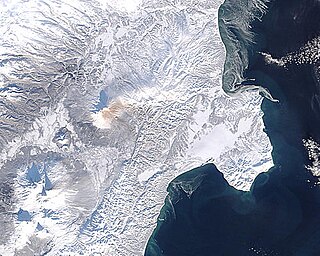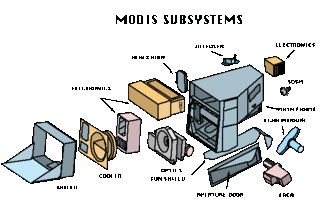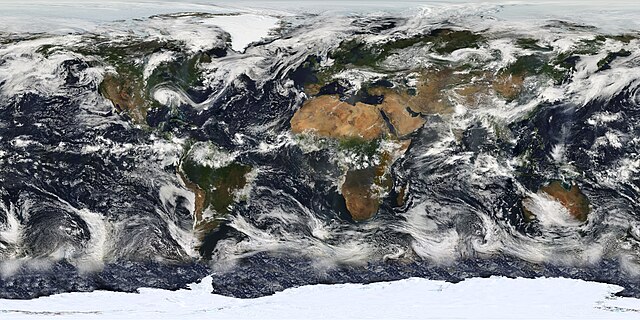Loading AI tools
Payload imaging sensor From Wikipedia, the free encyclopedia
The Moderate Resolution Imaging Spectroradiometer (MODIS) is a satellite-based sensor used for earth and climate measurements. There are two MODIS sensors in Earth orbit: one on board the Terra (EOS AM) satellite, launched by NASA in 1999; and one on board the Aqua (EOS PM) satellite, launched in 2002. MODIS has now been replaced by the VIIRS,[citation needed] which first launched in 2011 aboard the Suomi NPP satellite.







The MODIS instruments were built by Santa Barbara Remote Sensing.[1] They capture data in 36 spectral bands ranging in wavelength from 0.4 μm to 14.4 μm and at varying spatial resolutions (2 bands at 250 m, 5 bands at 500 m and 29 bands at 1 km). Together the instruments image the entire Earth every 1 to 2 days. They are designed to provide measurements in large-scale global dynamics including changes in Earth's cloud cover, radiation budget and processes occurring in the oceans, on land, and in the lower atmosphere.
Support and calibration is provided by the MODIS characterization support team (MCST).[2]
This section needs expansion. You can help by adding to it. (September 2014) |
With its high temporal resolution although low spatial resolution, MODIS data are useful to track changes in the landscape over time. Examples of such applications are the monitoring of vegetation health by means of time-series analyses with vegetation indices,[3] long term land cover changes (e.g. to monitor deforestation rates),[4][5][6][7] global snow cover trends,[8][9] water inundation from pluvial, riverine, or sea level rise flooding in coastal areas,[10] change of water levels of major lakes such as the Aral Sea,[11][12] and the detection and mapping of wildland fires in the United States.[13] The United States Forest Service's Remote Sensing Applications Center analyzes MODIS imagery on a continuous basis to provide information for the management and suppression of wildfires.[14]
| Specifications | |
|---|---|
| Orbit | 705 km, 10:30 a.m. descending node (Terra) or 1:30 p.m. ascending node (Aqua), Sun-synchronous, near-polar, circular |
| Scan rate | 20.3 rpm, cross track |
| Swath | 2330 km (cross track) by 10 km (along track at nadir) |
| Dimensions | |
| Telescope | 17.78 cm diam. off-axis, afocal (collimated), with intermediate field stop |
| Size | 1.0 × 1.6 × 1.0 m |
| Weight | 228.7 kg |
| Power | 162.5 W (single orbit average) |
| Data rate | 10.6 Mbit/s (peak daytime); 6.1 Mbit/s (orbital average) |
| Quantization | 12 bits |
| Spatial resolution | 250 m (bands 1–2) 500 m (bands 3–7) 1000 m (bands 8–36) |
| Temporal resolution | 1–2 days [15] |
| Design life | 6 years |
MODIS utilizes four on-board calibrators in addition to the space view in order to provide in-flight calibration: solar diffuser (SD), solar diffuser stability monitor (SDSM), spectral radiometric calibration assembly (SRCA), and a v-groove black body.[16] MODIS has used the marine optical buoy for vicarious calibration.
| Band | Wavelength (nm) |
Resolution (m) |
Primary use |
|---|---|---|---|
| 1 | 620–670 | 250 | Land/cloud/aerosols boundaries |
| 2 | 841–876 | 250 | |
| 3 | 459–479 | 500 | Land/cloud/aerosols properties |
| 4 | 545–565 | 500 | |
| 5 | 1230–1250 | 500 | |
| 6 | 1628–1652 | 500 | |
| 7 | 2105–2155 | 500 | |
| 8 | 405–420 | 1000 | Ocean color/ phytoplankton/ biogeochemistry |
| 9 | 438–448 | 1000 | |
| 10 | 483–493 | 1000 | |
| 11 | 526–536 | 1000 | |
| 12 | 546–556 | 1000 | |
| 13 | 662–672 | 1000 | |
| 14 | 673–683 | 1000 | |
| 15 | 743–753 | 1000 | |
| 16 | 862–877 | 1000 | |
| 17 | 890–920 | 1000 | Atmospheric water vapor |
| 18 | 931–941 | 1000 | |
| 19 | 915–965 | 1000 | |
| Band | Wavelength (μm) |
Resolution (m) |
Primary use |
| 20 | 3.660–3.840 | 1000 | Surface/cloud temperature |
| 21 | 3.929–3.989 | 1000 | |
| 22 | 3.929–3.989 | 1000 | |
| 23 | 4.020–4.080 | 1000 | |
| 24 | 4.433–4.498 | 1000 | Atmospheric temperature |
| 25 | 4.482–4.549 | 1000 | |
| 26 | 1.360–1.390 | 1000 | Cirrus clouds water vapor |
| 27 | 6.535–6.895 | 1000 | |
| 28 | 7.175–7.475 | 1000 | |
| 29 | 8.400–8.700 | 1000 | Cloud properties |
| 30 | 9.580–9.880 | 1000 | Ozone |
| 31 | 10.780–11.280 | 1000 | Surface/cloud temperature |
| 32 | 11.770–12.270 | 1000 | |
| 33 | 13.185–13.485 | 1000 | Cloud top altitude |
| 34 | 13.485–13.785 | 1000 | |
| 35 | 13.785–14.085 | 1000 | |
| 36 | 14.085–14.385 | 1000 | |
The following MODIS Level 3 (L3) datasets are available from NASA, as processed by the Collection 5 software.[17]
| Daily | 8-day | 16-day | 32-day | Monthly | Yearly | Grid | Platform | Description |
|---|---|---|---|---|---|---|---|---|
| MxD08_D3 | MxD08_E3 | — | — | MxD08_M3 | — | 1° CMG | Terra, Aqua | Aerosol, cloud water vapor, ozone |
| MxD10A1 | MxD10A2 | — | — | — | — | 500 m SIN | Terra, Aqua | Snow cover |
| MxD11A1 | MxD11A2 | — | — | — | — | 1000 m SIN | Terra, Aqua | Land surface temperature/emissivity |
| MxD11B1 | — | — | — | — | — | 6000 m SIN | Terra, Aqua | Land surface temperature/emissivity |
| MxD11C1 | MxD11C2 | — | — | MxD11C3 | — | 0.05° CMG | Terra, Aqua | Land surface temperature/emissivity |
| — | — | MxD13C1 | — | MxD13C2 | — | 0.05° CMG | Terra, Aqua | Vegetation indices |
| MxD14A1 | MxD14A2 | — | — | — | — | 1000 m SIN | Terra, Aqua | Thermal anomalies, fire |
| — | — | — | — | MCD45A1 | — | 500 m SIN | Terra+Aqua | Burned area |
| 250 m SIN | 500 m SIN | 1000 m SIN | 0.05° CMG | 1° CMG | Time window | Platform | Description |
|---|---|---|---|---|---|---|---|
| MxD09Q1 | MxD09A1 | — | — | — | 8-day | Terra, Aqua | Surface reflectance |
| — | — | — | MxD09CMG | — | Daily | Terra, Aqua | Surface reflectance |
| — | MCD12Q1 | — | MCD12C1 | — | Yearly | Terra+Aqua | Land cover type |
| — | MCD12Q2 | — | — | — | Yearly | Terra+Aqua | Land cover dynamics
(global vegetation phenology) |
| MxD13Q1 | MxD13A1 | MxD13A2 | MxD13C1 | — | 16-day | Terra, Aqua | Vegetation indices |
| — | — | MxD13A3 | MxD13C2 | — | Monthly | Terra, Aqua | Vegetation indices |
| — | MCD43A1 | MCD43B1 | MCD43C1 | — | 16-day | Terra+Aqua | BRDF/albedo model parameters |
| — | MCD43A3 | MCD43B3 | MCD43C3 | — | 16-day | Terra+Aqua | Albedo |
| — | MCD43A4 | MCD43B4 | MCD43C4 | — | 16-day | Terra+Aqua | Nadir BRDF-adjusted reflectance |

Seamless Wikipedia browsing. On steroids.
Every time you click a link to Wikipedia, Wiktionary or Wikiquote in your browser's search results, it will show the modern Wikiwand interface.
Wikiwand extension is a five stars, simple, with minimum permission required to keep your browsing private, safe and transparent.